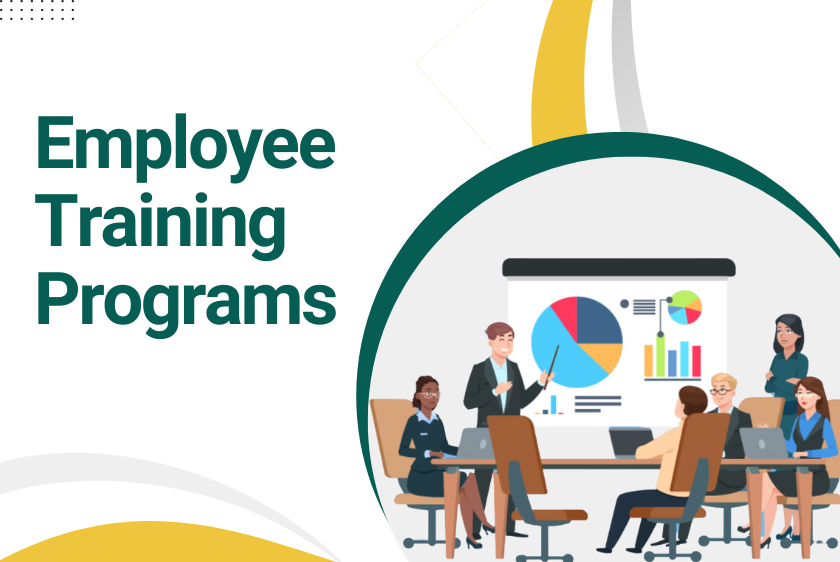
Are you experiencing high employee turnover, frequent errors, or low morale in your workplace? These are common problems that arise when employee training is neglected. In the absence of well-structured training programs, employees struggle to keep up with industry standards, feel unmotivated, and eventually leave for better opportunities. Effective development programs are crucial for fostering a productive, engaged, and loyal workforce. But how can you ensure your training program is effective? Here are seven steps to guide you through implementing a successful employee training program.
Steps To Develop a Result-oriented Employee Training Program-
1. Identify Training Needs
The very first step in any successful training program is to recognize the specific needs of your organization and employees. Conducting a needs assessment will help you understand the knowledge and skills gaps that need to be addressed. This can be done through:

Surveys and Questionnaires: Ask employees about their training needs and areas in which they feel less confident.
Interviews and Focus Groups: Engage with managers and employees in discussions to gain deeper insights.
Performance Reviews: Analyze past performance data to identify patterns that suggest a need for training.
Observation: Watch employees as they perform their tasks to spot inefficiencies or knowledge gaps.
Understanding these needs will ensure that the employee training program is relevant and targeted, addressing the specific requirements of your workforce.
2. Set Clear Objectives
Once you have identified the training requirements, the next step is to set clear and measurable objectives. What do you want to achieve through this training program? Objectives should be SMART:
Specific: Clearly write down what you want to achieve.
Measurable: Establish criteria for calculating progress and success.
Achievable: Ensure the goals are attainable within the given time frame and resources.
Relevant: Align objectives with broader organizational goals.
Time-bound: Set a time period for achieving the objectives.
Clear objectives provide direction and a benchmark for evaluating the training program’s effectiveness.
3. Design the Training Program
With clear objectives in place, you can start designing the employee training program. This involves selecting the right training methods, materials, and resources. Consider the following approaches:
Workshops and Seminars: Interactive sessions that encourage participation and engagement.
E-Learning: Online courses and modules that allow for flexible, self-paced learning.
On-the-Job Training: Practical, hands-on experience that integrates learning with work tasks.
Mentoring and Coaching: Personalized guidance from experienced employees or external coaches.
Blended Learning: A mix of different training methods to cater to various learning styles.
Ensure that the training content is engaging, interactive, and aligned with the set objectives.
4. Develop Training Materials
Developing high-quality training materials is crucial for the success of your program. These materials should be:
Comprehensive: Cover all necessary topics and skills.
Easy to Understand: Make use of clear language and avoid complex terminology.
Relevant: Ensure content aligns with training objectives and current industry standards.
Engaging: Incorporate visuals, case studies, and interactive elements to maintain interest.
Utilize a variety of materials such as manuals, slides, videos, and interactive modules. Regularly update these materials to keep them current and relevant.
5. Implement the Training Program
Now, it’s time to roll out the employee training program. Effective implementation requires careful planning and coordination. Consider these steps:
Scheduling: Plan training sessions at times that minimize disruption to work.
Resources: Ensure all necessary materials and equipment are available.
Trainers: Select qualified trainers who are knowledgeable and can engage participants.
Environment: Create a comfortable and conducive learning environment.
Participation: Encourage active involvement through discussions, activities, and Q&A sessions.
Provide ongoing support and resources to both trainers and trainees to ensure a smooth implementation.
6. Monitor and Evaluate
Monitoring and evaluating the employee training program is essential to measure its effectiveness. Collect feedback from participants through:
Surveys and Quizzes: Gather immediate reactions and measure knowledge retention.
Assessments: Test employees’ skills and knowledge post-training.
Observations: Monitor changes in performance and behavior.
Feedback Sessions: Hold follow-up meetings to discuss the impact of the training.
Analyze this feedback to find areas for improvement and measure the achievement of training objectives. Regular evaluation helps make necessary adjustments and continuously improve the program.
7. Follow-Up and Support
Training should not end with the completion of the program. Follow-up and ongoing support are crucial to reinforce regular learning and ensure the application of new skills:
Additional Resources: Provide supplementary materials, such as articles, videos, and e-books, to reinforce learning.
Coaching and Mentoring: Offer ongoing guidance to help employees apply their new skills on the job.
Regular Check-Ins: Schedule follow-up meetings to talk about progress and address any challenges employees may face.
Refresher Courses: Periodically offer refresher training sessions to keep employees’ skills up-to-date.
Regular follow-up will help maintain momentum and ensure long-term success.
Final say!
Implementing a successful employee training program is a strategic investment that pays off in the long run. By following these steps, you can create a training program that empowers your employees, drives business success, and fosters continuous improvement culture. Remember, the key to a fruitful training program is to focus on the needs of your employees and align training with your organization’s goals.
Follow us:







